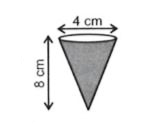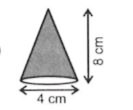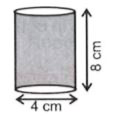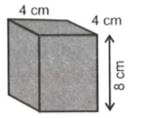Which of the following objects exerts the maximum pressure on the floor? (All objects have same mass.)




The correct Answer is:A
To determine which object exerts the maximum pressure on the floor, we need to understand the concept of pressure. Pressure is defined as the force applied per unit area. The formula for pressure (P) is given by:
P=FA
Where:
- P = Pressure
- F = Force (in this case, the weight of the object)
- A = Area over which the force is applied
Since all objects have the same mass, they will exert the same weight (force) on the floor due to gravity. Therefore, the pressure exerted by each object will depend on the area of contact (A) with the floor.
1. Identify the Mass of Each Object: Since all objects have the same mass, we can denote this mass as m.
2. Calculate the Weight of Each Object: The weight (force) of each object can be calculated using the formula:
F=m⋅g
where g is the acceleration due to gravity (approximately 9.81m/s2). Since m is the same for all objects, the weight will also be the same.
3. Determine the Area of Contact for Each Object: The area of contact (A) will vary depending on the shape and size of each object. For example, a sharp object like a needle will have a smaller area compared to a flat object like a book.
4. Calculate the Pressure for Each Object: Using the pressure formula:
P=FA
Since F is constant for all objects, the pressure will be inversely proportional to the area of contact. This means that the smaller the area, the greater the pressure.
5. Compare the Pressures: The object with the smallest area of contact will exert the maximum pressure on the floor.
Conclusion:
To find out which object exerts the maximum pressure, we need to compare the areas of contact of all the given objects. The object with the smallest area will exert the maximum pressure.
- P = Pressure
- F = Force (in this case, the weight of the object)
- A = Area over which the force is applied
F=m⋅g
where g is the acceleration due to gravity (approximately 9.81m/s2). Since m is the same for all objects, the weight will also be the same.
P=FA
Since F is constant for all objects, the pressure will be inversely proportional to the area of contact. This means that the smaller the area, the greater the pressure.
To find out which object exerts the maximum pressure, we need to compare the areas of contact of all the given objects. The object with the smallest area will exert the maximum pressure.
Topper's Solved these Questions
Similar Questions
Knowledge Check
Which of the following would exert maximum osmotic pressure?
ADecimolar aluminium sulphateBDecimolar barium chlorideCDecimolar sodium chlorideDA solution obtained by mixing equal volumes of (B) and (C) and filteringWhich of the following would exert maximum osmotic pressure?
ADecinormal aluminium sulphateBDecinormal barium chlorideCDecinormal sodium chlorideDA solution obtained by mixing equal volumes of (b) and (c) and filteringWhich of the following objects is translucent?
AMetal sheetBDiamondCMuddy waterDSugar solution
Which of the following is an objective question?
View SolutionWhich of the following objects is a non-luminous object?
View SolutionWhich of the following objects does not have more than one type of motion?
View SolutionWhich of the following have same mass ?
View SolutionWhich of the following have the same mass?
View Solution
